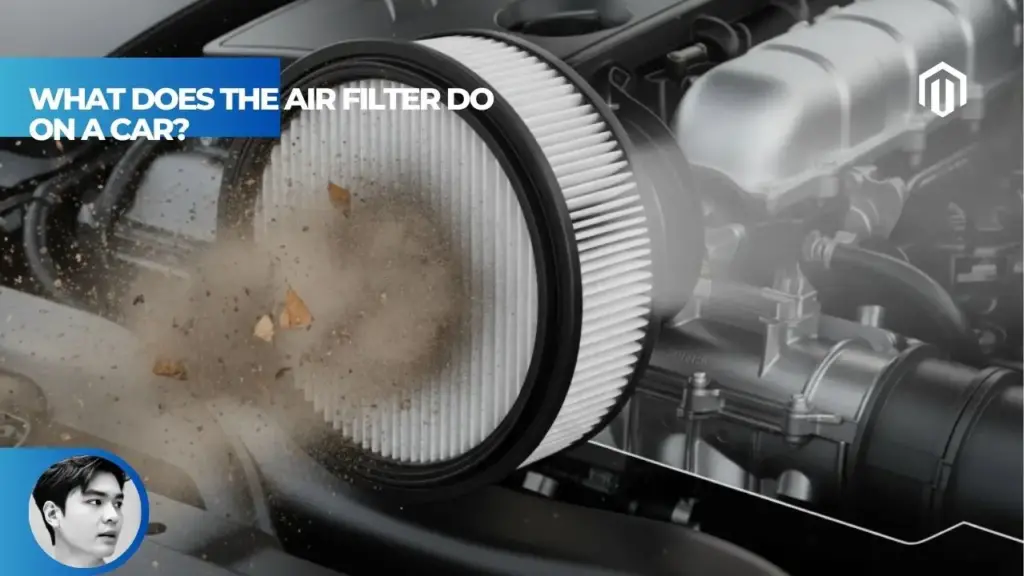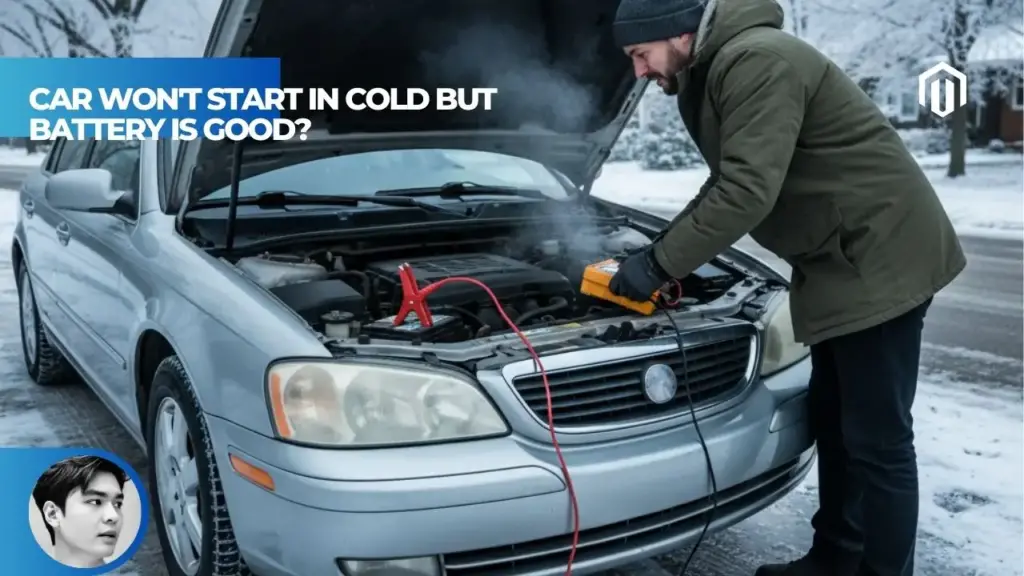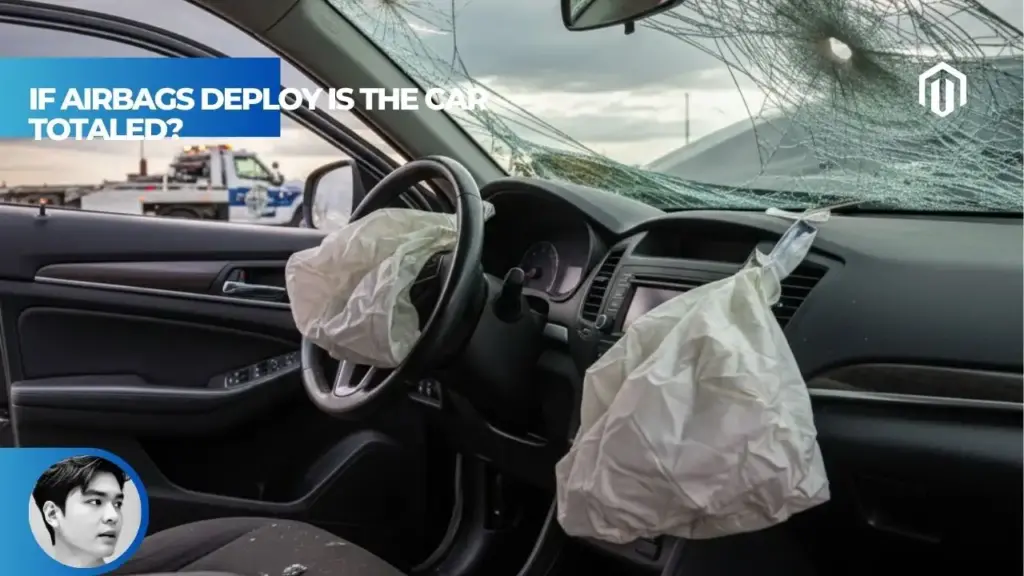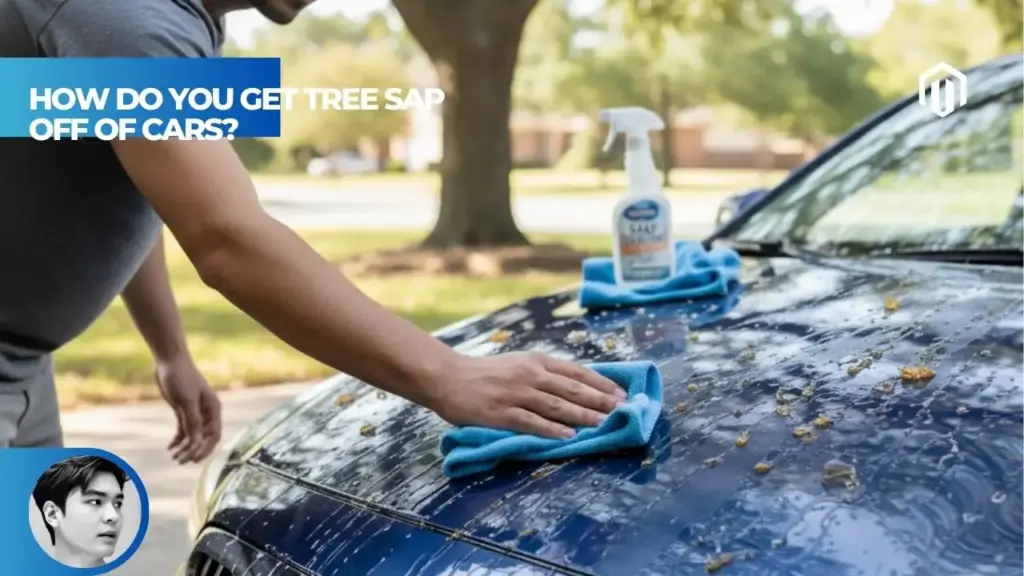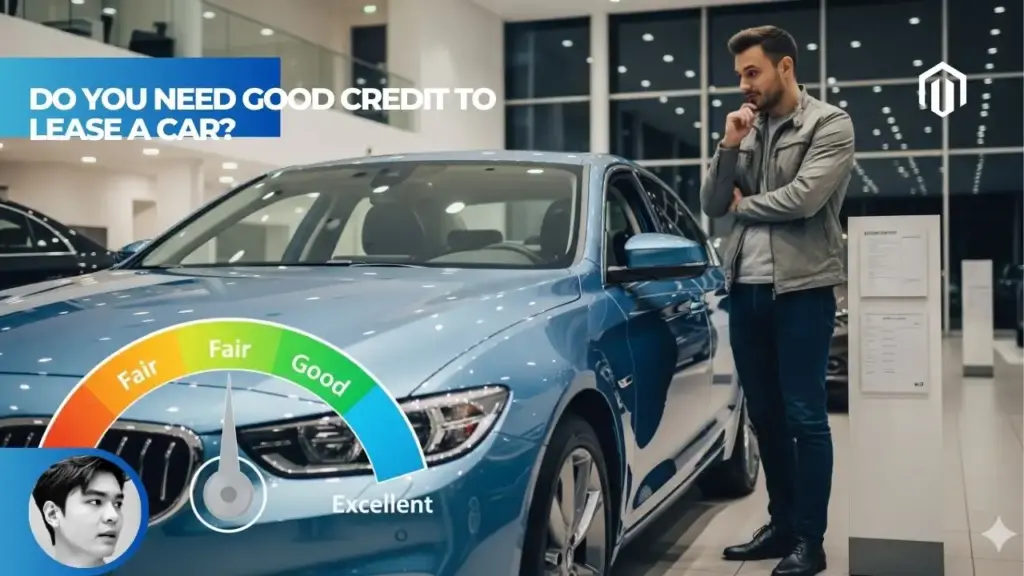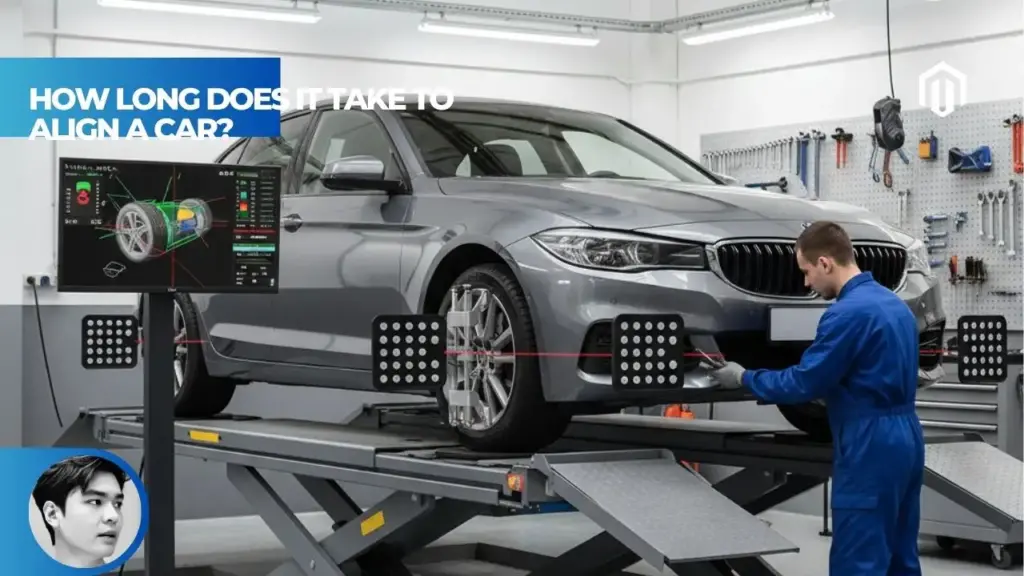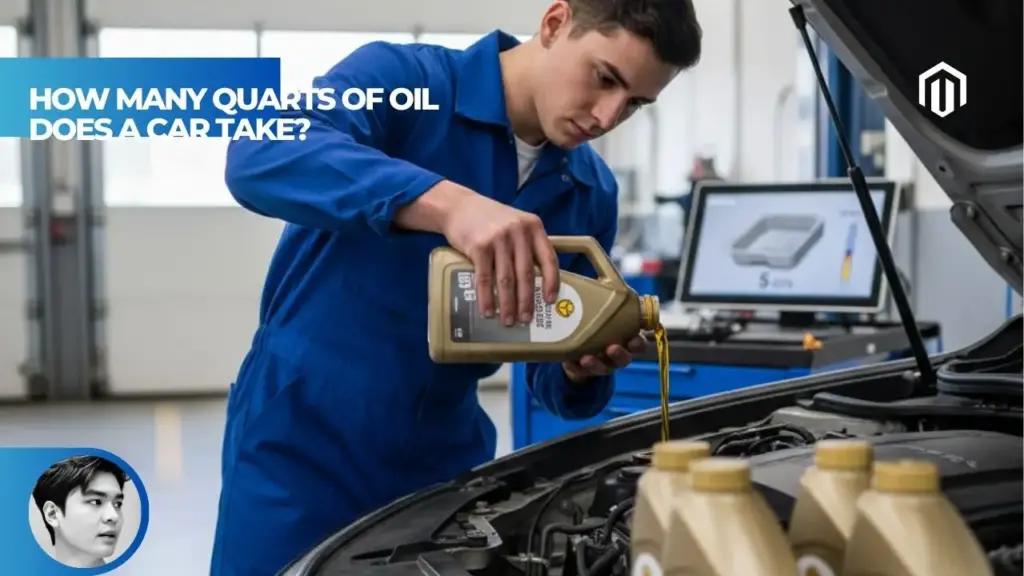You may also like:
- 【Explained】What Does an Air Filter Do in a Car? (Engine vs. Cabin Filter Explained)
- 【Explained】What Is a Microfilter on a BMW? (A Full Guide)
- 【Explained】How to Fix Car AC Blowing Hot Air? DIY Troubleshooting Guide
- 【Explained】What Engine Does the BMW i8 Have? Full Hybrid Powertrain Explained
- 【Explained】How Can You Tell If Your Car Is Overheating? A Quick Guide to Spotting the First Signs
A car’s air filter acts as your engine’s protective shield, trapping dirt, dust, and debris before they enter the combustion chamber. This crucial component ensures optimal air-fuel mixture for efficient combustion, improving performance by up to 10% and preventing costly internal engine damage.
Every breath your engine takes passes through this vital barrier first. Whether you’re a new driver learning basic maintenance or a seasoned car owner looking to optimize performance, understanding your air filter’s function can save you thousands in repairs while keeping your vehicle running smoothly for years.
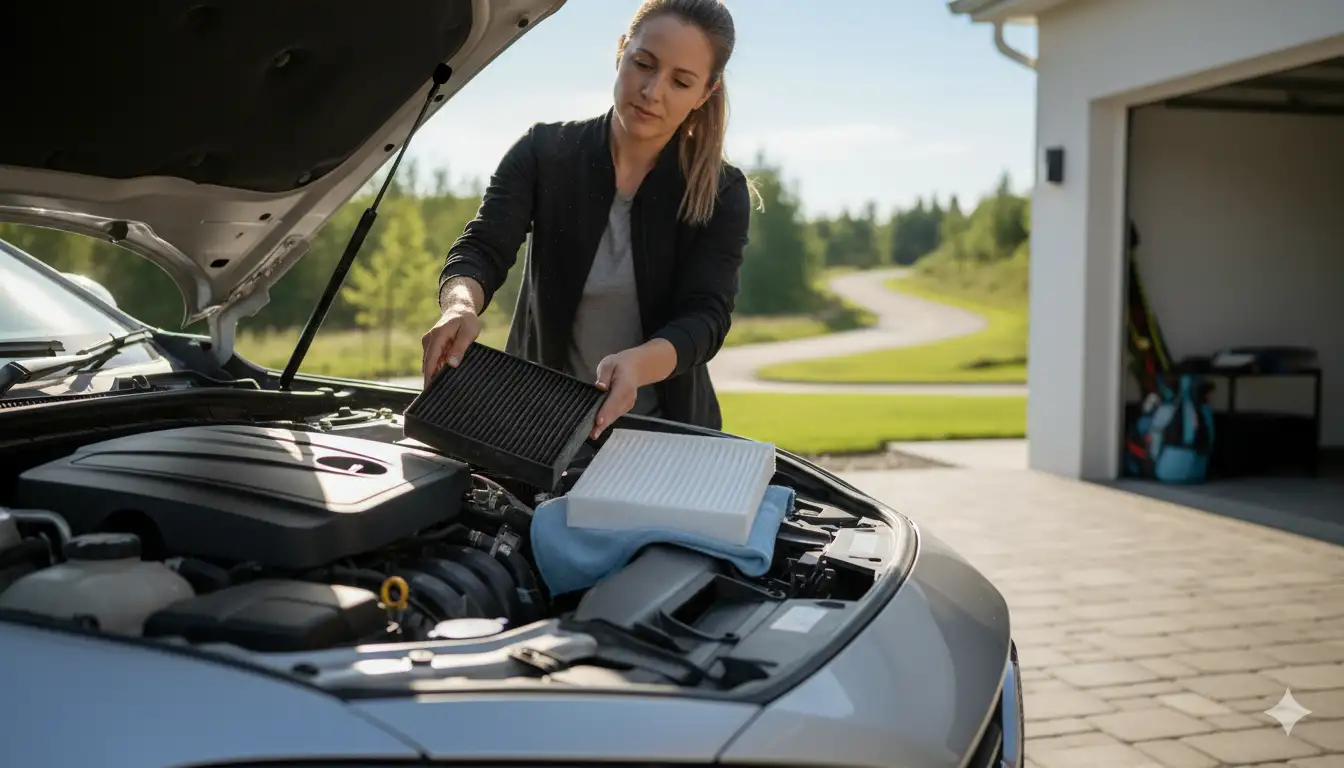
What Does a Car Air Filter Do in Simple Terms
Engine Protection from Contaminants
Your car’s air filter serves as the first line of defense against harmful particles that would otherwise destroy your engine. Think of it as a sophisticated screen that captures everything from microscopic dust particles to larger debris like leaves and insects before they can enter your engine’s delicate internal components[1].
The average vehicle inhales approximately 12,000 gallons of air for every gallon of fuel it burns. Without proper filtration, this massive volume of air would carry countless contaminants directly into your engine’s combustion chambers, causing accelerated wear on pistons, cylinders, and valves.
Modern engines operate with extremely tight tolerances—sometimes measured in thousandths of an inch. Even tiny particles can score cylinder walls, damage piston rings, and contaminate engine oil, leading to premature failure. According to Autvex automotive experts, a quality air filter can capture particles as small as 5 microns, protecting these precision-engineered components from unnecessary damage.
Ensuring Proper Air-Fuel Mixture for Combustion
The internal combustion engine requires a precise ratio of air to fuel for optimal performance—typically 14.7 parts air to 1 part fuel for gasoline engines[2]. Your air filter plays a critical role in maintaining this balance by ensuring consistent, unobstructed airflow to the engine.
When properly maintained, the air filter allows your engine’s computer to accurately calculate fuel injection based on incoming air volume. The mass air flow sensor, positioned after the filter, measures this clean air and sends data to the engine control module for precise fuel metering.
| Air-Fuel Ratio | Condition | Engine Impact |
|---|---|---|
| 14.7:1 | Optimal (Stoichiometric) | Maximum efficiency, clean combustion |
| 12:1-13:1 | Rich (excess fuel) | Reduced economy, carbon buildup |
| 15:1-17:1 | Lean (excess air) | Higher temperatures, potential damage |
How Air Filters Work as Your Car’s Lungs
Just as your lungs filter air before it enters your bloodstream, your car’s air filter cleanses incoming air before it reaches the engine’s combustion chambers. The filter media—typically made of pleated paper or synthetic materials—creates a maze-like path that traps contaminants while allowing clean air to pass through.
The pleated design maximizes surface area within a compact space. A standard engine air filter contains 10-15 square feet of filter media folded into a frame roughly the size of a hardcover book. This design ensures adequate airflow even as the filter accumulates dirt over time.
Air enters through the vehicle’s intake system, often located near the front grille or fender area. It then passes through the airbox containing the filter element before continuing to the throttle body and intake manifold. This journey takes mere milliseconds, but the filtration process is remarkably effective at removing harmful particles.
Engine Performance Benefits of Clean Air Filters
Improved Fuel Efficiency and Economy
A clean air filter can improve fuel economy by up to 10% in older carbureted vehicles and provide noticeable improvements in modern fuel-injected engines[3]. When airflow is unrestricted, your engine doesn’t have to work as hard to draw in the oxygen it needs for combustion.
The U.S. Department of Energy confirms that replacing a clogged air filter is one of the most cost-effective ways to improve fuel efficiency. For the average driver covering 12,000 miles annually, this translates to savings of $150-300 per year at current fuel prices.
Consider this real-world example: A driver with a 2025 BMW 5 Series noticed their fuel economy drop from 28 mpg to 24 mpg over several months. After replacing the severely clogged air filter, economy immediately returned to normal levels—a 17% improvement worth hundreds of dollars annually.
Better Acceleration and Horsepower
Modern engines equipped with clean air filters demonstrate measurably better acceleration and power output. Testing shows that vehicles with new filters can improve 0-60 mph times by 6-11% compared to those with heavily contaminated filters[3].
The relationship between airflow and power is direct—more air means more oxygen for combustion, which enables more fuel to be burned effectively. Performance enthusiasts often upgrade to high-flow aftermarket filters specifically for this reason, though standard OEM filters provide excellent performance when clean.
Turbocharged engines show even greater sensitivity to air filter condition. These forced-induction systems rely on precise airflow measurements and can lose significant boost pressure with restricted filters, potentially triggering limp mode or reduced power warnings.
Reduced Emissions and Environmental Impact
Clean air filters contribute significantly to reducing vehicle emissions by ensuring complete fuel combustion. When engines receive adequate air supply, they burn fuel more completely, producing fewer harmful byproducts like carbon monoxide and unburned hydrocarbons.
Environmental Protection Agency (EPA) data indicates that proper air filtration can reduce hydrocarbon emissions by up to 25% in vehicles with compromised filters[4]. This improvement benefits both air quality and helps vehicles pass mandatory emissions testing.
The environmental benefits extend beyond tailpipe emissions. Better fuel efficiency means less fuel consumption overall, reducing both carbon footprint and dependence on fossil fuels. It’s a simple maintenance item with far-reaching environmental implications.
Types of Car Air Filters Explained
Engine Air Filter vs Cabin Air Filter Differences
Many drivers confuse engine air filters with cabin air filters, but these components serve entirely different purposes. The engine air filter protects your motor’s internal components, while the cabin air filter cleans air entering the passenger compartment through the ventilation system.
| Feature | Engine Air Filter | Cabin Air Filter |
|---|---|---|
| Location | Engine compartment/airbox | Behind dashboard/glove box |
| Purpose | Protects engine components | Improves interior air quality |
| Replacement interval | 12,000-30,000 miles | 15,000-25,000 miles |
| Cost | $15-50 | $20-40 |
| Impact if neglected | Engine damage, poor performance | Musty odors, reduced AC efficiency |
Engine air filters directly affect vehicle performance and longevity, making them critical for mechanical health. Cabin filters, while important for comfort and health, don’t impact engine operation. Both deserve regular attention but serve distinct functions in your vehicle’s overall system.
Filter Media Materials: Paper, Cotton, and Synthetic Filters
The filter media material significantly impacts both filtration efficiency and airflow characteristics. Paper filters remain the most common OEM choice, offering excellent filtration at an affordable price point—typically $15-25 for quality replacements.
Cotton gauze filters, often oiled for enhanced particle capture, provide superior airflow and can be cleaned and reused. These performance-oriented options cost $50-75 initially but last the vehicle’s lifetime with proper maintenance. Performance vehicle enthusiasts often choose these for their flow characteristics.
Synthetic filters represent the latest technology, combining excellent filtration with good airflow and extended service intervals. Made from polyester or similar materials, they resist moisture better than paper and typically last 50% longer between changes, though they cost $25-40 on average.
OEM vs Aftermarket and Performance Air Filters
Original Equipment Manufacturer (OEM) filters are designed specifically for your vehicle’s requirements, ensuring proper fit and meeting all warranty specifications. These filters typically cost $20-50 and provide reliable protection with predictable replacement intervals.
Aftermarket filters range from budget replacements to high-performance options. Quality aftermarket filters from reputable manufacturers like FRAM, WIX, or Bosch often match or exceed OEM specifications at lower prices. However, extremely cheap filters may compromise filtration efficiency for cost savings.
Performance air filters promise increased horsepower and improved throttle response. While gains are typically modest—5-15 horsepower in naturally aspirated engines—the improved airflow can enhance driving feel. Autvex recommends ensuring any performance filter maintains adequate filtration to protect your investment.
Dirty Air Filter Symptoms and Problems
Restricted Airflow and Sluggish Engine Performance
A clogged air filter creates a bottleneck in your engine’s breathing system, forcing it to work harder for every breath. Drivers typically notice sluggish acceleration, especially when merging onto highways or climbing hills, as the engine struggles to get sufficient oxygen for optimal combustion[5].
The symptoms progressively worsen as contamination builds. Initially, you might notice slightly delayed throttle response. As restriction increases, the engine may hesitate during acceleration, feel underpowered, or struggle to maintain highway speeds.
Modern engines with electronic throttle control may mask early symptoms by adjusting parameters to compensate. However, this compensation has limits—severely restricted filters will eventually overwhelm the system’s ability to adapt, resulting in noticeable performance degradation.
Check Engine Light and Engine Misfire Signs
While a dirty air filter rarely triggers the check engine light directly in modern vehicles, severe restriction can cause related issues that illuminate this warning. The most common scenario involves disruption of the air-fuel mixture leading to misfires or oxygen sensor readings outside normal parameters[6].
Engine misfires occur when combustion fails in one or more cylinders. A severely clogged filter can create such a rich fuel mixture that spark plugs become fouled with carbon deposits, preventing proper ignition. You’ll feel this as rough idling, stuttering during acceleration, or engine vibration.
Turbocharged vehicles are particularly susceptible to filter-related check engine lights. These systems monitor boost pressure closely, and restricted airflow can trigger codes P0299 (turbo underboost) or similar warnings when the turbocharger cannot achieve expected pressure levels.
Black Exhaust Smoke and Rough Idling
Black exhaust smoke indicates incomplete combustion caused by excessive fuel relative to available air—a direct result of severe air filter restriction. This visible symptom means your engine is running rich, wasting fuel and potentially damaging catalytic converters through carbon buildup[5].
Rough idling manifests as engine vibration, inconsistent RPMs, or stalling at traffic lights. The engine control module struggles to maintain stable combustion when airflow is unpredictable, causing these uncomfortable and potentially dangerous symptoms.
Additional symptoms include:
- Unusual engine sounds (popping, backfiring)
- Gasoline smell from the exhaust
- Reduced engine power under load
- Difficulty starting, especially when cold
- Excessive fuel consumption beyond normal
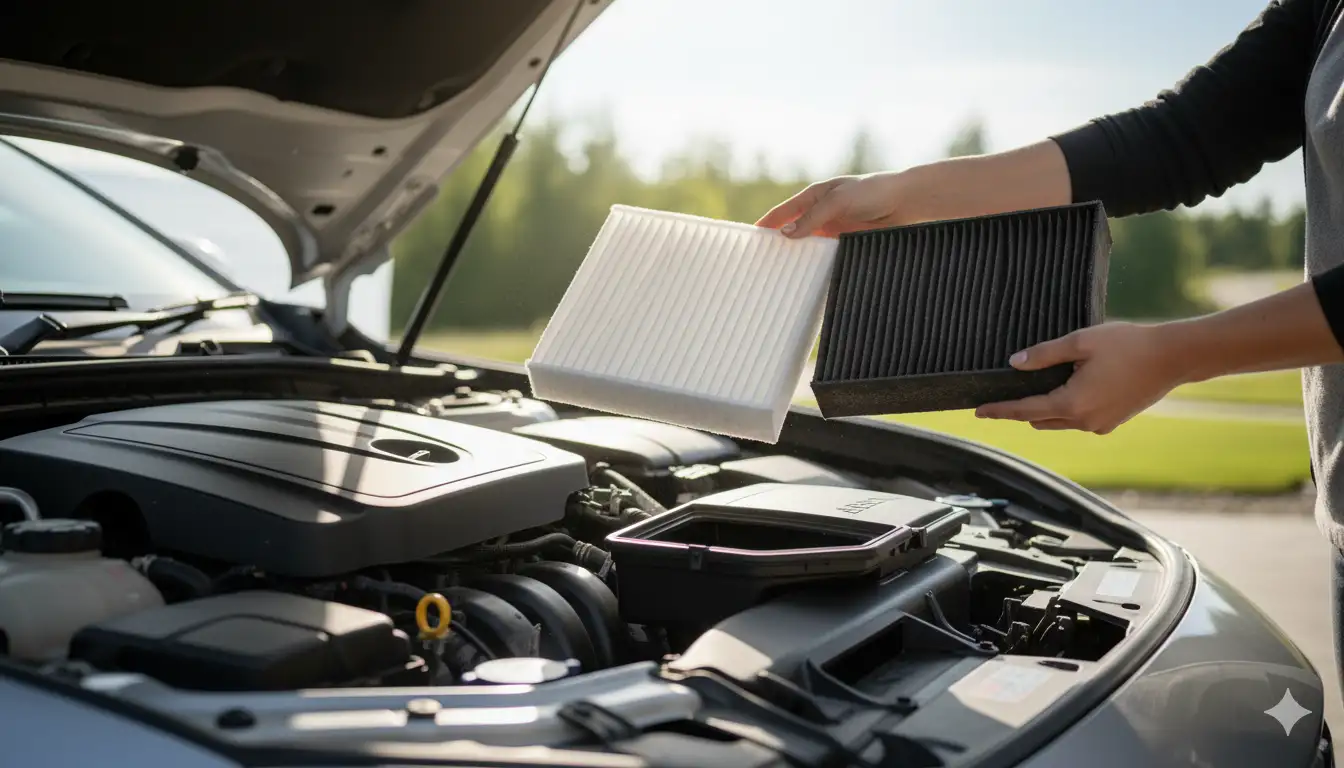
When to Change Your Air Filter
Air Filter Replacement Intervals and Owner’s Manual Guidelines
Most manufacturers recommend replacing engine air filters every 12,000-15,000 miles under normal driving conditions, though some extend this to 30,000 miles for highway-focused driving[7]. Your owner’s manual provides specific guidance tailored to your vehicle’s engineering requirements.
The “severe service” schedule applies to many drivers without their knowledge. If you regularly encounter any of these conditions, consider replacing your filter every 6,000-8,000 miles:
- Stop-and-go traffic
- Dusty or unpaved roads
- Construction zones
- Agricultural areas
- Extreme temperatures
Time also affects filter media. Even low-mileage vehicles should replace filters annually, as the media can degrade from moisture, temperature cycles, and atmospheric ozone exposure.
Driving Conditions Impact: Dusty and Off-Road Driving
Environmental conditions dramatically affect filter lifespan. Desert regions, construction zones, and agricultural areas expose filters to significantly higher contamination levels. A filter that might last 30,000 miles in suburban Seattle could need replacement after just 5,000 miles in rural Arizona.
Off-road enthusiasts face particular challenges. A single day of trail driving can clog a filter that would normally last months. Many off-road vehicles feature snorkel intakes or pre-filters to extend filter life in extreme conditions.
| Driving Environment | Recommended Interval | Inspection Frequency |
|---|---|---|
| Highway primarily | 20,000-30,000 miles | Every oil change |
| Suburban/mixed | 12,000-15,000 miles | Every 5,000 miles |
| Urban/stop-and-go | 8,000-12,000 miles | Every 3,000 miles |
| Dusty/agricultural | 5,000-8,000 miles | Monthly |
| Off-road/extreme | After each trip | Before and after use |
How to Check Air Filter Condition
Visual inspection remains the most reliable method for assessing filter condition. Remove the filter from its housing and hold it up to bright light—if light barely passes through, replacement is needed regardless of mileage.
The “tap test” provides quick field assessment: gently tap the filter on a hard surface. If excessive dirt falls out, the filter is heavily loaded. However, some dirt release is normal and doesn’t necessarily indicate replacement need.
Professional inspection tools measure actual airflow restriction. Many shops offer free filter inspection during oil changes. These measurements provide objective data about filter performance, removing guesswork from replacement decisions.
DIY Air Filter Change vs Professional Service
DIY Air Filter Change Process
Changing your air filter represents one of the easiest DIY maintenance tasks, typically requiring 10-15 minutes and no special tools. Most filters are accessible by releasing clips or removing screws from the airbox cover in the engine compartment.
Basic steps for DIY replacement:
- Locate the airbox (usually a black plastic box near the engine)
- Release clips or remove screws securing the cover
- Note the filter’s orientation before removal
- Remove the old filter carefully to avoid dropping debris
- Clean the airbox interior with a shop vacuum
- Install the new filter with correct orientation
- Secure the airbox cover completely
Common mistakes include installing filters backward (check for airflow arrows), leaving the airbox improperly sealed, or choosing incorrect filter sizes. Always verify part numbers against your owner’s manual or the old filter before purchase.
Air Filter Cost Considerations
DIY filter replacement offers significant savings compared to professional service. Retail filter prices range from $12-50 depending on quality and vehicle requirements, while shops typically charge $40-100 for parts and labor[2].
Budget breakdown for different options:
- Economy paper filter: $12-20 (DIY) vs $40-60 (shop)
- Premium paper filter: $20-35 (DIY) vs $50-80 (shop)
- Performance/reusable: $50-75 (DIY) vs $80-120 (shop)
Annual savings from DIY replacement average $30-60, money better spent on quality engine oil or other maintenance items. The investment in basic tools pays for itself with just one or two filter changes.
Mechanic Air Filter Change Benefits
Professional installation ensures proper fit and complete system inspection. Technicians check related components like the mass air flow sensor, intake boots, and airbox seals that DIY enthusiasts might overlook.
Shops maintain service records valuable for warranty claims and resale value. They also properly dispose of old filters, ensuring environmental compliance. Some facilities offer free filter inspection with oil changes, providing expert assessment without commitment.
Professional service makes sense when:
- Filter location requires significant disassembly
- You’re uncomfortable with DIY maintenance
- Time is more valuable than money saved
- Other services are being performed simultaneously
- Warranty requires documented professional service
Air Intake System Components
Air Filter Housing and Airbox
The airbox serves as more than just a filter holder—it’s an engineered component designed to optimize airflow while minimizing noise and turbulence. Modern airboxes incorporate resonance chambers that cancel specific sound frequencies and smooth airflow patterns before reaching the filter[8].
Construction typically uses high-density polyethylene or similar plastics resistant to heat, chemicals, and vibration. The housing must maintain an airtight seal to prevent unfiltered air bypass while allowing easy access for maintenance. Design considerations include water drainage provisions to prevent filter saturation during heavy rain.
Aftermarket cold air intake systems replace the entire airbox assembly, repositioning the filter away from engine heat. While these can improve performance, they may increase intake noise and potentially void warranties if not properly designed for your specific vehicle.
Mass Air Flow Sensor (MAF) and Throttle Body
The mass air flow sensor, positioned between the air filter and throttle body, measures incoming air volume and temperature. This critical data allows the engine control module to calculate precise fuel injection timing and quantity. A contaminated MAF sensor from poor filtration can cause driveability issues and trigger check engine lights.
MAF sensors use either hot-wire or hot-film technology to measure air mass. Contamination from oil or dirt affects readings, causing symptoms like:
- Rough idle or stalling
- Hesitation during acceleration
- Poor fuel economy
- Black exhaust smoke
- Check engine codes P0171/P0174 (lean) or P0172/P0175 (rich)
The throttle body controls airflow volume into the engine based on accelerator pedal position. Modern electronic throttle bodies integrate multiple sensors and require clean airflow for proper operation. Carbon buildup from poor filtration can cause sticky operation or require expensive cleaning services.
Intake Manifold Connection
The intake manifold distributes filtered air evenly to each cylinder, with design varying significantly between naturally aspirated and forced-induction engines. This aluminum or composite plastic component must withstand pressure variations while maintaining consistent flow characteristics to each combustion chamber.
Modern variable-length intake manifolds adjust runner length based on engine speed, optimizing torque across the RPM range. These complex systems are particularly sensitive to contamination, with stuck actuators causing poor performance and diagnostic trouble codes.
Connection points between the air filter system and intake manifold use rubber boots or couplers that deteriorate over time. According to Autvex service data, these connections should be inspected during filter changes for cracks or loose clamps that could allow unfiltered air entry.
Long-Term Engine Health and Maintenance
Engine Longevity Through Proper Filtration
Consistent air filter maintenance can extend engine life by 50,000-100,000 miles according to fleet maintenance studies[1]. The cumulative effect of clean filtration prevents microscopic wear that compounds over years of operation.
Consider the mathematics: a typical engine inhaling contaminated air ingests approximately 2 tablespoons of dirt annually. Over 100,000 miles, this becomes pounds of abrasive material grinding away at precision components. Proper filtration reduces this to negligible amounts.
Real-world example: A fleet of delivery vehicles split into two groups—one with standard 15,000-mile filter intervals, another with 7,500-mile changes in dusty conditions. After 200,000 miles, the frequently-serviced group showed 40% less cylinder wear and averaged 18% better compression test results.
Preventing Piston Damage and Valve Wear
Pistons and valves represent the most vulnerable engine components to contamination-related damage. Silicon particles from road dust are particularly destructive, being harder than most engine metals and acting like grinding compound on cylinder walls.
Piston rings rely on precise sealing to maintain compression and control oil consumption. Contamination accelerates ring wear, leading to:
- Increased oil consumption (1 quart per 1,000 miles or worse)
- Blue exhaust smoke from oil burning
- Reduced compression and power loss
- Catalyst damage from oil contamination
- Complete engine rebuild requirement ($3,000-8,000)
Valve seats and guides suffer similar abrasive wear. Intake valves are especially vulnerable as they’re directly exposed to incoming air. Worn valve guides allow oil consumption while damaged seats prevent proper sealing, causing compression loss and rough running.
Routine Maintenance and Car Care Tips
Integrate air filter inspection into your regular maintenance routine. Check the filter whenever checking engine oil, looking for obvious contamination or damage. Document replacement dates and mileage for trend analysis.
Create a comprehensive maintenance schedule:
- Every 3,000 miles: Visual filter inspection
- Every 7,500 miles: Thorough filter evaluation
- Every 12,000-15,000 miles: Filter replacement (normal conditions)
- Every 6,000-8,000 miles: Filter replacement (severe conditions)
- Annually: Replace regardless of mileage
Complementary maintenance enhances filter effectiveness. Keep the engine compartment clean to reduce contamination sources. Ensure hood seals are intact to minimize dirt entry. Address oil leaks promptly as oil-contaminated filters lose efficiency rapidly.
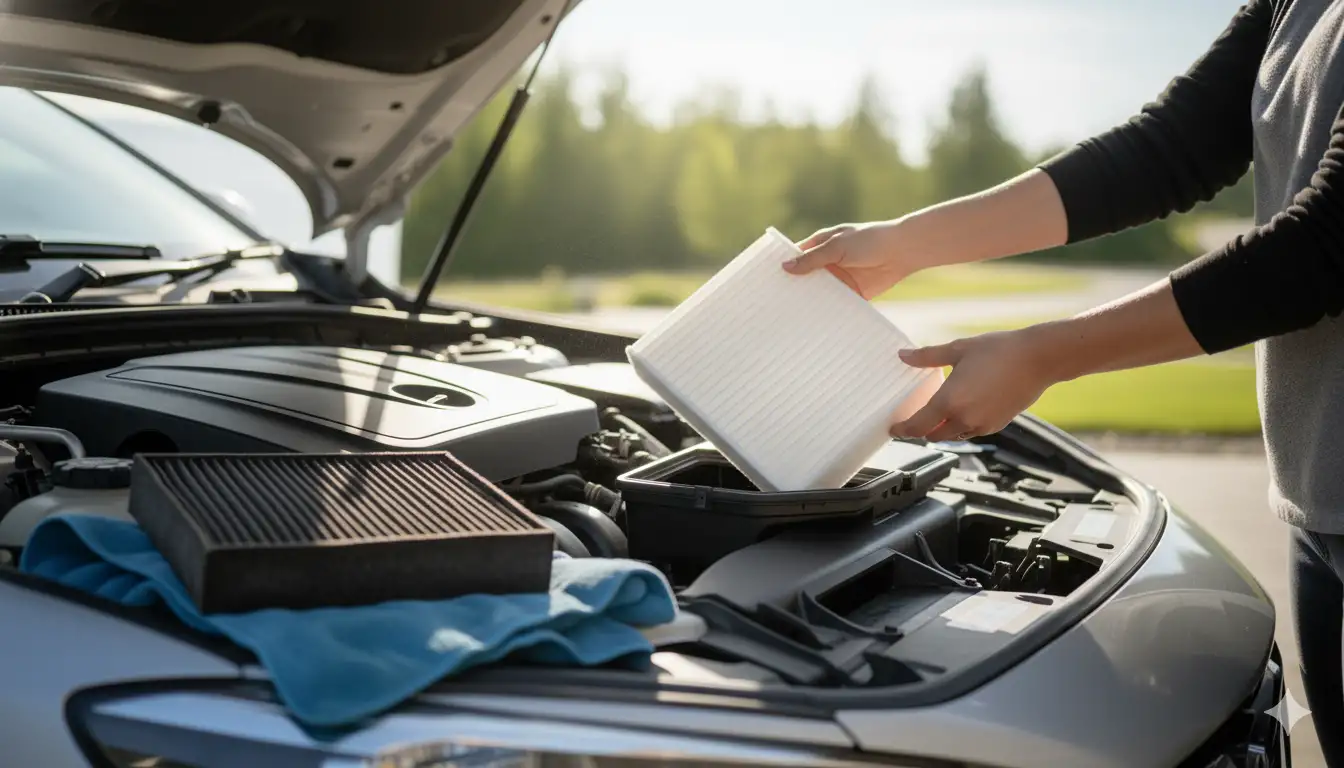
Key Takeaways
- Air filters trap harmful contaminants protecting engine internals from damage
- Replace filters every 12,000-15,000 miles or annually for optimal performance
- Clean filters improve fuel economy by up to 10% in some vehicles
- DIY replacement costs $12-50 versus $40-100 for professional service
- Check engine lights may indicate severely restricted airflow requiring immediate attention
- Different filter media types offer varying benefits for specific driving needs
- Proper filtration extends engine life by preventing premature component wear
Next Steps
Inspect your air filter today—it takes just five minutes and could save hundreds in fuel costs and thousands in engine repairs. Locate your airbox using the owner’s manual, remove the filter, and hold it to bright light. If visibility is poor or you can’t remember the last replacement, order a new filter immediately.
Set calendar reminders for regular filter inspection based on your driving conditions. Urban drivers should check every oil change, while rural or dusty-condition drivers need monthly inspections. Consider upgrading to a high-quality filter if operating in severe conditions regularly.
Research the correct filter part number for your vehicle and purchase a spare to keep on hand. Compare prices between Autvex-recommended suppliers and local parts stores. Document replacement dates in your maintenance log for warranty protection and resale value. For performance enthusiasts, investigate whether cold air intake systems suit your driving style and budget requirements.
Frequently Asked Questions
What does a car air filter do, in simple terms?
A car’s air filter acts like a protective screen, preventing dirt, dust, and debris from entering the engine while ensuring clean air reaches the combustion chambers for optimal performance and efficiency.
What happens if I don’t change my car’s air filter?
Driving with a dirty filter reduces fuel efficiency by up to 10%, decreases engine performance, causes sluggish acceleration, and can lead to serious engine damage costing thousands in repairs over time.
How often should I change my car’s air filter?
Most manufacturers recommend replacing the engine air filter every 12,000-15,000 miles or once yearly under normal conditions, though dusty environments may require changes every 6,000-8,000 miles for proper protection.
Is an air filter the same as a cabin air filter?
No, an engine air filter cleans air entering your engine for combustion and affects performance, while a cabin filter cleans air entering the passenger compartment for breathing comfort and health.
Can a new air filter improve car performance?
Yes, a clean filter ensures proper airflow for optimal combustion, improving fuel economy by up to 10%, providing better acceleration response, and restoring overall engine performance to specification levels.
Can I change my car’s air filter myself?
Yes, most vehicles allow DIY air filter changes in 10-15 minutes using basic tools, though professional service ensures proper installation, system inspection, and documentation for warranty purposes.
What are the signs of a dirty air filter?
Common signs include decreased fuel efficiency, reduced engine power, unusual engine sounds, black exhaust smoke, rough idling, and potentially the check engine light illuminating in severe cases.
References
- PG Filters. (2024). Can Replacing Your Air Filter Improve Gas Mileage. https://www.pgfilters.com/resources/articles/can-replacing-your-air-filter-improve-gas-mileage/
- Genesis Santa Monica. (2022). How Often to Change Your Cabin and Engine Air Filters. https://www.genesissantamonica.com/blog/2022/january/15/how-often-to-change-your-cabin-and-engine-air-filters.htm
- London CDJR. (2014). How Does a Clean Air Filter Improve Your Car’s Performance. https://www.londoncdjr.com/air-filter-car-performance.html
- Windsor Nissan. (2023). The Benefits of Regularly Changing Car Air Filters. https://www.windsornissan.com/blog/importance-of-changing-car-air-filters
- Jessup Auto Plaza. (2025). How a Dirty Air Filter Affects Performance. https://www.jessupautoplaza.com/blogs/7398/how-a-dirty-air-filter-affects-performance/
- PG Filters. (2024). Can a Contaminated Air Filter Cause a Check Engine Light. https://www.pgfilters.com/resources/articles/can-a-contaminated-air-filter-cause-a-check-engine-light/
- Jiffy Lube. (2025). How Often to Change Car Air Filter. https://www.jiffylube.com/resource-center/how-often-to-change-car-air-filter
- Yuma Honda. (2023). The Benefits of Regular Engine Air Filter Replacement. https://www.yumahonda.com/blogs/5484/the-benefits-of-regular-engine-air-filter-replacement-performance-and-efficiency

I am a senior automotive analyst at Autvex. Expert vehicle evaluations, in-depth reviews, and objective analysis helping readers make informed automotive decisions with years of industry experience.

